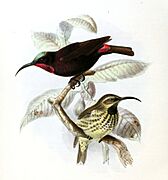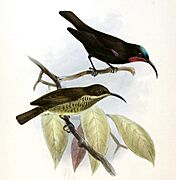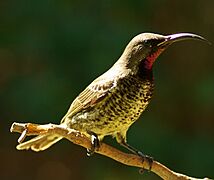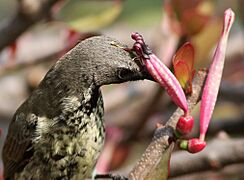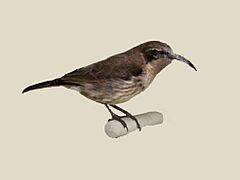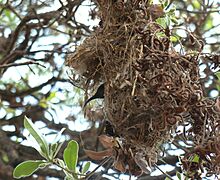Amethyst sunbird facts for kids
Quick facts for kids Amethyst sunbird |
|
|---|---|
 |
|
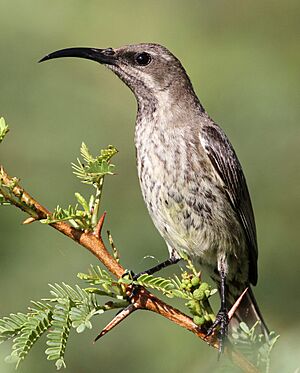 |
|
| Nominate male and female, South Africa | |
| Conservation status | |
| Scientific classification | |
| Genus: |
Chalcomitra
|
| Species: |
amethystina
|
| Synonyms | |
|
Nectarinia amethystina |
|
The amethyst sunbird, also known as the black sunbird (Chalcomitra amethystina), is a beautiful bird found in Africa. It belongs to the sunbird family. These birds mostly live south of the equator in places with plenty of water. They often move around during different seasons to find flowering trees. While some forests they live in have shrunk, they have also started living in gardens, which has helped their numbers grow in some areas.
Contents
What Do Amethyst Sunbirds Do?
Amethyst sunbirds are usually seen alone or in pairs. But if there's a tree full of flowers, many of them might gather there. They can be quite bossy towards other sunbirds! Their song is a loud, long, chattering sound.
What Do They Eat?
These birds love to eat nectar from flowers. They also snack on spiders and termites that come out of the ground.
How Do They Find a Mate?
When a male wants to impress a female, he hops around on a branch near her. He will drop one wing, then the other, and then both wings. He then flutters his wings to show them off. If the female likes what she sees, she might lower her head and stand very still.
Building a Nest
Amethyst sunbird pairs build their nests far apart from each other. The female is the main builder. They often choose trees like eucalyptus or pine, sometimes even near buildings or people.
Where Are Nests Built?
Nests are usually attached to a branch that hangs down, below the main leaves of the tree. They can also be hidden by thick leaves. The nests are made from thin grass stems, held together with cobwebs. The birds often decorate their nests with small pieces of lichen or other bits of nature.
Eggs and Chicks
A female sunbird lays two speckled eggs. She might even raise more than one group of chicks from the same nest in one season! Sometimes, other birds like the green-backed honeybird and Klaas's cuckoo lay their eggs in the sunbird's nest, letting the sunbirds raise their chicks.
Where Do They Live and How Do They Move?
Amethyst sunbirds live in many different places across Africa. You can find them in woodlands, savannas (grassy areas with scattered trees), forest edges, and even in gardens in towns.
Where Are They Less Common?
They are not often seen in very dry savannas or low, dry areas. In these places, they stick to areas near rivers or where there are many plants with nectar. They are quite rare in the Limpopo valley and mopane tree regions.
Seasonal Travels
During summer, many amethyst sunbirds move into the Zambezi valley and the woodlands near Great Zimbabwe. They are only summer visitors (from September/October to April) to the Kalahari sand woodlands. Here, you can see lots of them when the Baikiaea trees are blooming. Near the coast, they are very common residents, living up to 1,800 meters high in mountain forests and bushy valleys.
Amazing Adaptations
Amethyst sunbirds have special ways their bodies work to help them live in different places.
Oxygen and Flying
Most birds have a certain level of red blood cells (called hematocrit) that carry oxygen. Amethyst sunbirds have a higher level than average! This helps them carry more oxygen, which is important for their small bodies and for the energy needed to fly.
Living at Different Altitudes
You can find amethyst sunbirds from the Drakensberg mountains to the coast in South Africa. In warmer months, birds living at higher altitudes (where it's colder and there's less oxygen) have even higher hematocrit levels. This helps them get enough oxygen in thin air.
Body Temperature and Energy
Different groups of amethyst sunbirds can change how their bodies use energy and control temperature. Birds that live in high altitudes have lower energy needs and can handle a wider range of temperatures. This means the amethyst sunbird can change its body to best suit its environment, whether it's high up in the mountains or down by the coast!
How Are Their Numbers Doing?
In some areas, like the Mashonaland plateau, the kirkii type of amethyst sunbird has become fewer. This is because their natural miombo woodlands have been broken up. However, in South Africa, the main type of amethyst sunbird has actually spread more as people have planted more gardens with trees.
Where Can You Find Them?
Amethyst sunbirds live in many countries in Africa. These include Angola, Botswana, Burundi, Republic of the Congo, Democratic Republic of the Congo, Eswatini, Ethiopia, Gabon, Kenya, Malawi, Mozambique, Namibia, Somalia, South Africa, South Sudan, Tanzania, Uganda, Zambia, and Zimbabwe.
Different Types of Amethyst Sunbirds
Scientists have found a few different types, or "races," of the amethyst sunbird. They look a little different depending on where they live. Here are a couple of examples:
- C. a. amethystina: This type is found in South Africa, southern Botswana, and Eswatini. The males have metallic purple tail feathers.
- C. a. kirkii: This type lives from Zimbabwe up to East Africa. The males have dark brown tail feathers instead of purple.
Gallery



